
When we’re trying to “tighten” something, we tend to think about fixing the object so that it cannot move at all.
However, “tight screwing” does not necessarily mean “secure tightening. ” It is important to tighten with appropriate torque. Excessive tightening may cause deformation or breakage of parts.
Also, the user should be careful about the protrusion of the gasket due to excessive tightening. The gasket between the piping or between the lid and the container may protrude into or out of the container or piping, resulting in poor sealing performance and contamination.
In this article, we will focus on the inside protrusion of the ferrule gasket. When the ferrule was tightened with a clamp, we experimented on how much the gasket protrudes due to the tightening torque.
1. The protruding gasket can cause contamination.
If the gasket between the ferrule protrudes into the piping or container, it may cause contamination. Please see the following two cases:
1. When the gasket itself becomes contaminant
If the gasket protrudes, the part may be worn out and may enter the container.
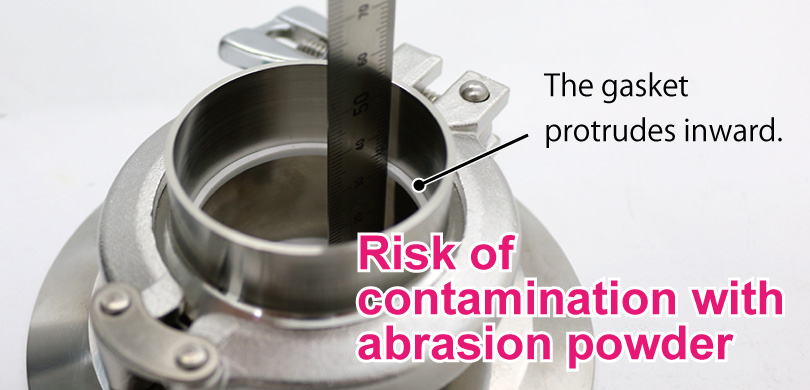
In particular, if the gasket of the connection part with piping and accessories is protruding, it is very easy to be worn out on that part.
It is risky that the worn-out part may get mixed into the container, or the deteriorated gasket may be torn and its fragments may get mixed in.
2. When residues adhering to the level difference of the gasket become contaminant
The protruding gasket makes a level difference. If the content remains or adheres to this extra step, there is a possibility that it may come off and get contaminated.
Residues can be removed by periodic cleaning, but these residues can be reduced by preventing the gasket from sticking out in the first place.
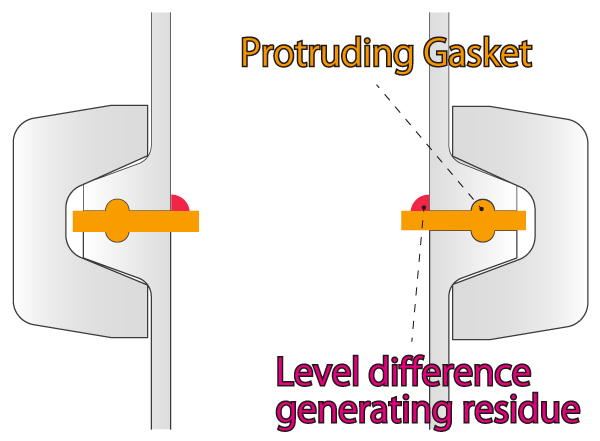
The difference in level may cause a decrease in liquid delivery efficiency.
If there is a difference in level in the piping, it will become a dead space, and it will become an obstacle for sending liquid. In order to maintain the efficiency of fluid delivery, please tighten the clamp with appropriate force.
2. Comparison of protrusion of gasket by tightening torque
Let’s do an experiment.
Insert the silicone rubber gasket between the pipes and tighten with the tri-clamp band.
First check the condition of manual tightening, then use a torque wrench and [TSC] torque management socket for tri-clamp band, and tighten the clamp with a torque of 3 N · m ~ 10 N · m.
Let’s check the pop-out of the gasket by visual observation and the change of the inner diameter of the gasket.
What is “Torque”?
“Torque” refers to a force that twists an axis or rotates an object.
In particular, the torque used to tighten screws, etc., is called “Tightening Torque” and is generally expressed in units of N ・ m.
Torque wrench is a tool for measuring and displaying this value.

For 4S size situation
First, let’s experiment with Ferrule, a size of 4S (IDF/ISO standard).
First of all, let’s check how the gasket is like by tightening it by hand without using a tool.
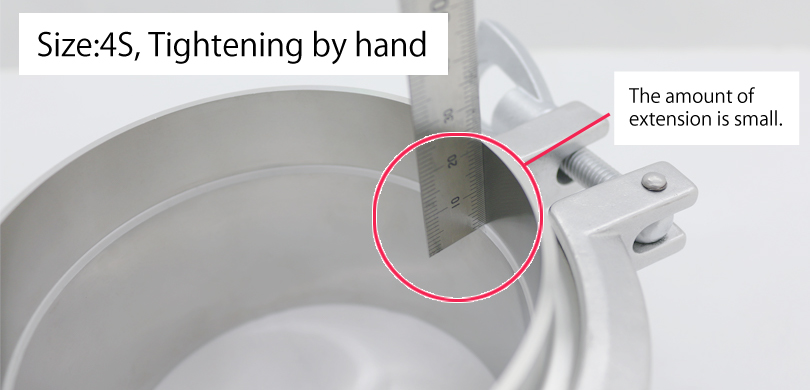
Even when it is tightened by hand, there is still a little protrusion can be seen. The inside diameter of the gasket is 96.86 mm.
Next, check how the bulge and inner diameter change as the tightening torque increases. Since the torque wrench used this time cannot measure 3N · m or less, manual tightening torque is not described.
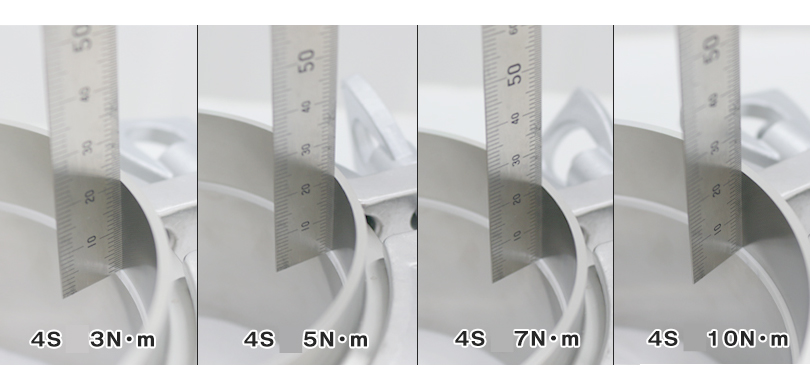
It may be hard to see in the picture, but when you measure the value, you can see that the inner diameter of the gasket decreases as the torque increases.
| Tightening Torque(N・m) | By Hand | 3.04 | 5.08 | 7.00 | 10.28 |
| I.D(mm) | Φ96.89 | Φ96.34 | Φ96.19 | Φ95.89 | Φ95.38 |
For 2S size situation
Similarly, let’s check out the situation of 2S size ferrule.
If you tighten it by hand, it will be in the following state. The inner diameter of the gasket is 46.93 mm.

You can see that 2S has a larger change in the protrusion than 4S. Even when tightening torque is approximately 3 N · m, the product protrudes more than when tightening by hand. The numerical changes are as follows:
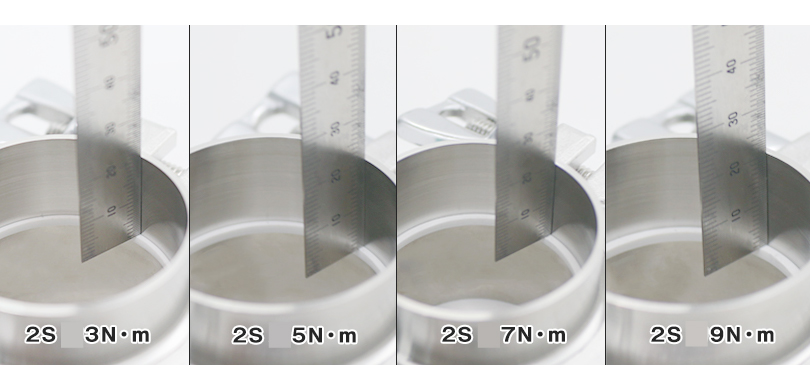
| Tightening Torque(N・m) | By Hand | 3.02 | 5.24 | 7.10 | 9.20 |
| I.D(mm) | Φ46.93 | Φ45.95 | Φ45.26 | Φ44.89 | Φ44.47 |
In the case of 4S, the inner diameter decreased by approximately 1 mm when tightening from approximately 3 N · m to 10 N · m, whereas in the case of 2S, the inner diameter decreased by approximately 1.5 mm when tightening from approximately 3 N · m to 9 N · m.
Outward extrusion
It can be confirmed that the tri-clamp band protrudes outward from the gap. The outward protrusion was smaller than the inward protrusion, and it did not protrude in the case of 4S.
Just because the outside doesn’t protrude doesn’t mean the gasket doesn’t protrude inside, so please be careful about this.
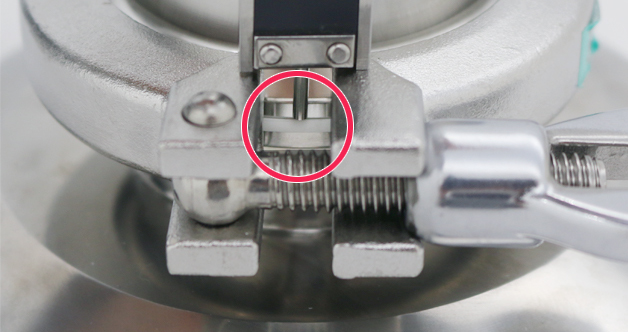
3. For avoiding excessive tightening
In this experiment, we confirmed that the gasket protruded inward in both 2S and 4S.
Generally, the appropriate tightening torque is around 3N · m. Therefore, it is necessary to allow the packing to protrude at a time of about 3N · m, but if the tightening is stronger than that, it will create dead space or unnecessarily increase the risk.
To eliminate this risk and waste, it is desirable to tighten the clamp lightly by hand and then use a torque wrench to tighten the clamp appropriately.
The [TSC] torque management socket for the clamp band is ideal for this. By attaching this socket to a commercially available torque wrench, the tightening torque of the clamp band can be measured. This product prevents excessive tightening and helps standardize tightening torque.
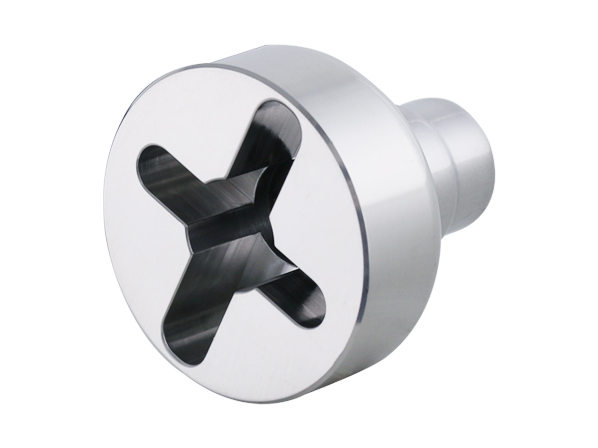
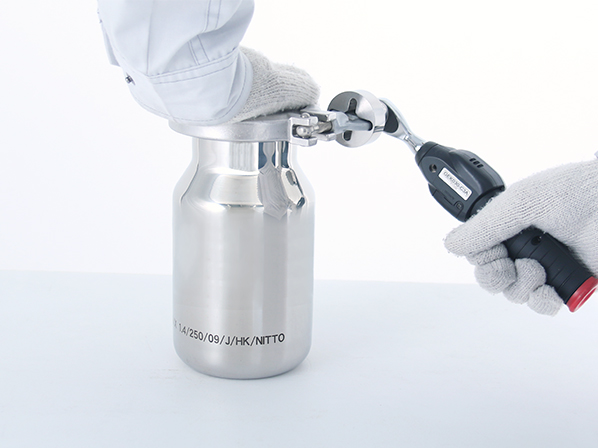
Since it is compatible with clamp bands of multiple manufacturers and models, it is safe to have this one. Even if the standard is not available, we can customize it to fit your needs, so please feel free to contact us.
4. Summary
When tightening the tri-clamp band, it is not always necessary to use very strong force. As you can see from this experiment, if the seal is tightened more than necessary, the gasket sealing will protrude, causing various risks.
Torque control is essential to prevent this situation from happening. Ideally, all operators should be able to tighten with appropriate torque under any circumstances.
In addition to the “TSC ” introduced at Nitto Kinzoku Kogyo, we can produce custom-made products such as “Torque-controlled bottles“; and in response to customer requests, and also introduce “special gasket with a SS ring on the outer circumference ” that does not easily protrude inwards. Using a torque-management tools can reduce unnecessary risk and waste, which is important and essential in the manufacturing process.
Tag Related Posts
- No related posts.
